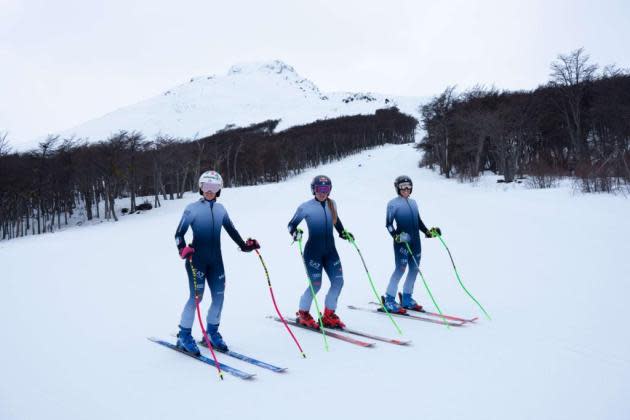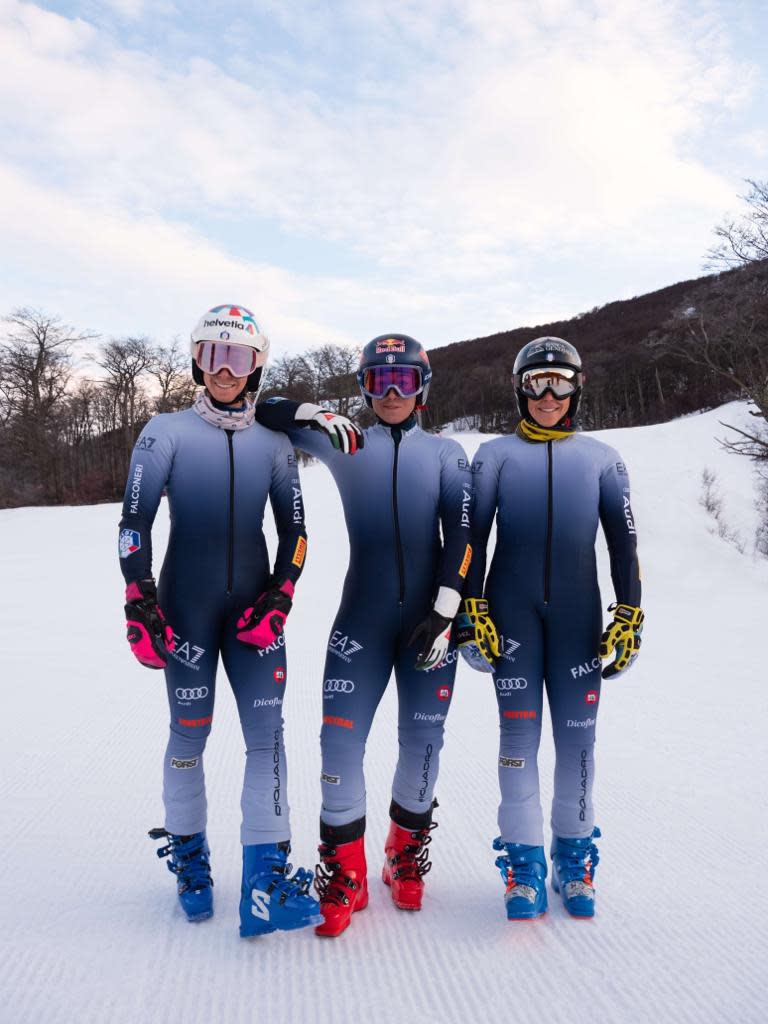Emporio Armani’s EA7 Unveils New Ski Suits for Italy’s Winter Sports Athletes

MILAN – In keeping with his love of sports, Giorgio Armani’s partnership with FISI, the Italian Winter Sports Federation, as its technical outfitter is continuing to grow.
The designer’s namesake company’s sportswear-leaning EA7 line under the Emporio Armani brand unveiled a new competition ski suit at the Armani/Teatro in Milan.
More from WWD
You Can Dress Like Them: Fashion Designers Talk About Their Runway Uniforms
Vuitton in Hong Kong, Amiri's Prize Finalists, Armani on the Slopes
The designer, who was not in attendance, lent his venue for the two-day event that kicks off the upcoming game season for the national federation with athletes in attendance already sporting leisure clothing and previewing the new ski suit.
“There are several shared values between Armani and skiing that triggered us to embrace this world, the main one being the commitment towards excellence,” Giuseppe Marsocci, deputy general manager of Giorgio Armani, said at the event. “Sport’s main value is passion, that’s a defining trait of any athlete that we share at Armani,” he said.
The new ski suits, crafted from high-tech textiles, feature a degrade effect with navy blue, a color that has defined the Armani aesthetic over the years, decking out the suit’s central portion and veering upward and downward to different sky-blue nuances and icy silver.
Italian alpine ski racer Marta Bassino previewed the suit for the audience and shared her feedback after testing it in Ushuaia, Argentina, where the Italian team has been training ahead of the season. “They are really beautiful with all the blue nuances… ski suits need to be comfortable but also performing… I’m sure the ones for the competitions, made from different fabrics, will be even better,” she offered.
“It’s a beautiful image for our athletes, I think,” echoed FISI’s president Flavio Roda. The executive touted the suits’ design and reiterated his appreciation for the four-season tie-up. This will stretch until the Milano Cortina 2026 Winter Olympics.
The competition is expected to generate buzz, draw interest and help boost the Italian economy. It will mark the third time Italy hosts the Winter Games after the 2006 edition in Turin and the 1956 edition in Cortina d’Ampezzo.

Although debate is currently swirling in Italy about the construction of a dedicated track for luge, skeleton and bobsledding, which the federation hopes can be built in Cortina d’Ampezzo to keep all Olympics competitions on Italian soil, the Val Gardena valley in the Dolomites has meanwhile applied to be the organizer of the 2029 FIS World Championships, signaling the federation’s commitment to boosting Italy’s winter sports scene.
Italian winter sports athletes are already a source of pride for the country, as the federation reported an excellent 2022-23 season with more than 200 podium wins across winter disciplines in the senior and junior divisions.
“The season was great, with many achievements, but it’s been a difficult and challenging one. We have to thank all the athletes for their constant and determined commitment,” Roda said. Two new sponsors have joined the roster of companies supporting the federation: Fistral and Enel.
As reported, the EA7 tie-up commenced last year entailed that Italian athletes sported EA7’s performance-driven gear, including ski suits, overalls, jackets and puffers; mid-layers; leisurewear such as track pants and tops, vests, shorts and T-shirts, as well as a range of accessories and sneakers.
Armani’s link with FISI in providing the team with technical outfits — previously supplied by the Robe di Kappa brand — can be seen as an expansion of the designer’s link with winter sports.
Through his EA7 Emporio Armani line, introduced in 2004, he was already the official outfitter of the Italian Olympic team, who wore the designer’s EA7 Emporio Armani kit during the opening ceremony of the Winter Olympic Games in Beijing last year.
His support of Italian sports teams dates back to 2012 for the London Olympic Games, followed by the 2014 Sochi Winter Olympics, in 2016 for the Olympics in Rio de Janeiro, at the 2018 Winter Games in South Korea and in 2020 for the Olympics in Tokyo. The designer has also already linked with winter sports via a partnership with Italian and Swiss ski schools.
Best of WWD

